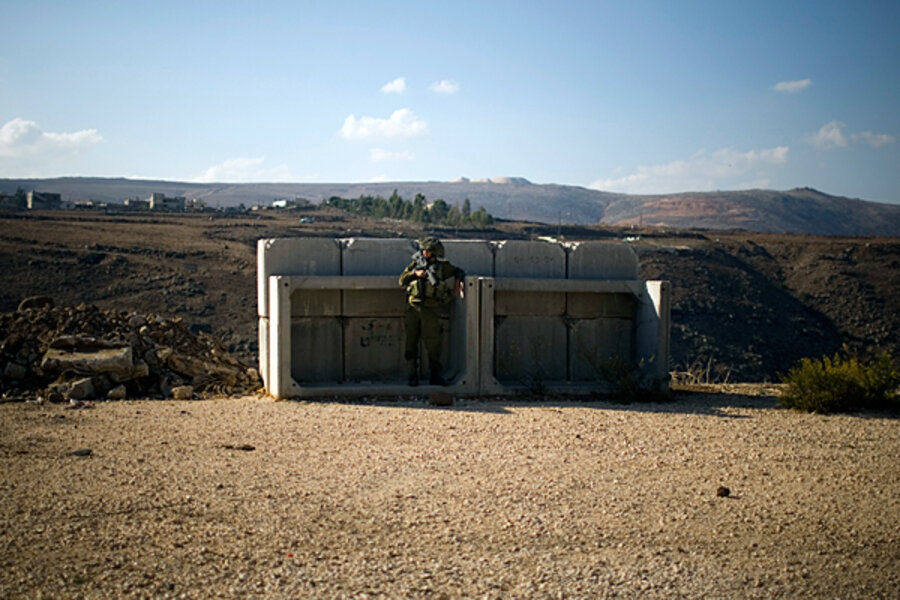Israel appears set to withdraw from Lebanese border town Ghajar, easing tensions
Loading...
| Wazzani, Lebanon
Intensive United Nations-led diplomacy appears to have encouraged Israel to withdraw its troops from part of a village that lies inside Lebanese territory but has remained under Israeli occupation since 2006.
Israeli Prime Minister Benjamin Netanyahu reportedly told UN Secretary-General Ban Ki Moon this week that he will convene a meeting of his inner security cabinet to approve a pullout from the divided village of Ghajar.
If the withdrawal occurs in the coming weeks, it will be one less bone of contention along a border that while presently calm has remained a potential flashpoint since the end of the month-long war in 2006 between Israel and Lebanon’s militant Shiite Hezbollah.
“We have been discussing with both parties the specifics of the withdrawal because of the specifics of the situation where the village is divided in two,” says Milos Strugar, the top political adviser in the UN peacekeeping force based in south Lebanon, known as UNIFIL. “UNIFIL within its mandate is there and ready to provide all the support required by all the parties.”
The significance of Ghajar
At first glance, it can be difficult to understand why so much fuss has surrounded Ghajar, a village of some 2,000 residents, all of whom are Alawites, an obscure offshoot of the Shiite sect. There is no permanent Israeli troop presence in the northern sector of the village – soldiers patrol it each day before returning to the southern, Israeli-controlled, side. The residents want to remain under Israeli authority and there has been no fighting in the area for 4-1/2 years.
Yet there are few border issues in the Middle East as tangled as that of Ghajar. The village owes its complicated status to the indifference of the French mandatory authorities in the 1920s that never clearly delineated the border between the new state of Lebanon and Syria. Successive Lebanese governments also ignored this remote rural pocket of southeast Lebanon, essentially turning the unmarked, unfenced, and poorly policed border into a smugglers' corridor.
Israeli troops overran Ghajar, then a small farming community, when it seized and occupied the adjacent Golan Heights in the 1967 Arab-Israeli war. The residents considered themselves Syrian nationals but accepted Israeli citizenship in 1981 when Israel formally annexed the territories occupied in 1967. Over the years, Ghajar grew wealthier and expanded in size.
In 2000, the Israeli government announced it would withdraw its troops from an occupied strip of south Lebanon, ending an occupation of 22 years. To facilitate the withdrawal, the UN composed a boundary, known as the Blue Line, conforming to Lebanon’s southern border with Israel and Israeli-occupied Syria (which included Ghajar). The UN cartographers discovered that the border cut through the middle of Ghajar, leaving the northern two thirds in Lebanon and the remainder in Israeli-occupied Syria.
In the years that followed, Hezbollah militants set up an outpost at the northern end of Ghajar and allegedly recruited some of the residents as spies to provide intelligence information from inside Israel in exchange for cash and drugs. An Israeli army officer at the time described the unfenced Ghajar as “Israel’s soft underbelly.” In the 2006 war, Israeli troops moved into the northern end of Ghajar and continue to patrol the neighborhood to this day in contravention of UN Security Council Resolution 1701, which helped end the month-long conflict.
But a decision by the Israeli government to end the troop incursions was complicated by the fact that Israeli citizens – residents of Ghajar – would be living on Lebanese territory. If one of them fell sick, would an Israeli doctor be permitted to cross the Blue Line into “Lebanese” Ghajar? The Israeli government also wanted assurances that Hezbollah would not be able to regain access to the northern end of the village and resurrect its intelligence networks.
UNIFIL mediated the negotiations between the Lebanese and Israelis at monthly “trilateral” meetings where both sides address and resolve various grievances.
'Live and let live'
The UN proposal, which has not been publicly detailed, appears to be a compromise in which the Lebanese army and UNIFIL will restrict access from Lebanon into the northern end of the village, while the residents of Ghajar will be permitted to conduct their normal lives regardless of which side of the Blue Line they live on.
“The thing that makes the ‘live and let live’ restoration possible is that the UN has corrected the one serious defect in the 2000-2006 arrangement by establishing a strong security cordon around the northern edge of the municipality, thereby rendering [Israeli army] patrols across the Blue Line absolutely unnecessary,” says a senior Western diplomat familiar with the negotiations over Ghajar.
From the nearby hills in Lebanon, Ghajar stands out as a blaze of whitewashed and pastel-colored buildings set in a plain of sun-bleached grass speckled with boulders of black basalt. A few years ago it was possible to reach northern Ghajar and talk to residents by walking along a footpath between an old Israeli security fence and a minefield. But UNIFIL peacekeepers and Lebanese soldiers have effectively sealed off Ghajar with checkpoints, fences, gates and watch towers.
Decades ago, the residents of Wazzani, a tiny impoverished village lying in Lebanon just west of Ghajar used to meet and chat with their Alawite neighbors while swimming in the Hasbani river, a small creek that runs through a gorge between the two villages. But there has been no contact between the two for a quarter century since Israeli forces ringed the village with fences and minefields.
“We welcome the Ghajar people who live on the northern side,” says Ahmad Mohammed, the mayor of Wazzani. “But we wish they would renounce their Israeli citizenship. They should only fly the Lebanese or Syrian flags on Lebanese soil.”





